As the automotive world shifts towards electrification and sustainable driving experiences, the competition in the SUV segment has become fierce. In this comparison, we take a closer look at two intriguing contenders: the Alfa Romeo Junior and the Ford Puma. Both SUVs embody unique characteristics, blending technology, performance, and comfort. Let’s explore their technical aspects and innovations to see how they stack up against each other.
Alfa Romeo Junior vs Ford Puma – Which one offers the better deal?
Two cars, one duel: Alfa Romeo Junior meets Ford Puma.
Which one wins in performance, efficiency and value for money? Find out now!
Design and Dimensions
Both the Alfa Romeo Junior and the Ford Puma exhibit contemporary SUV designs that are not only stylish but also practical. The Junior measures 4173 mm in length, 1781 mm in width, and stands 1533 mm tall, showcasing its compact and sporty demeanor. On the other hand, the Puma is slightly larger, ranging from 4186 to 4226 mm in length with a width of 1805 mm and a height of 1550 mm, providing a more robust presence on the road.
Engines and Performance
When it comes to engine options, the Junior offers both electric and petrol MHEV variants, with power outputs reaching up to 280 HP. Its 0-100 km/h acceleration time can be as quick as 5.9 seconds for the more powerful electric model, making it a strong performer. In contrast, the Ford Puma presents a range of petrol MHEV engines with up to 160 HP, achieving a respectable 0-100 km/h in just 7.4 seconds with its most powerful variant.
The Junior stands out with its electric options, providing an electric range of up to 410 km, alongside a battery capacity of 51 kWh. This positions it well for environmentally conscious drivers. The Puma, however, focuses solely on petrol engines, with fuel consumption figures ranging from 5.4 to 6 L/100 km, highlighting its efficiency among traditional combustion engines.
Transmission and Handling
Both models are equipped with user-friendly transmissions. The Alfa Romeo Junior comes with an automatic transmission, featuring a dual-clutch setup for smooth gear changes, while the Puma offers options for both manual and automatic transmissions, catering to a variety of driver preferences. Both vehicles employ front-wheel drive systems, which provide adequate handling and stability in various driving conditions.
Interior and Comfort
The interior layout of both SUVs is designed to provide comfort for five passengers. The Junior boasts a trunk capacity of 400 L, while the Puma offers slightly more space at 456 L, making it a more practical choice for families or those needing extra storage. Both design approaches emphasize an ergonomic and modern dashboard, integrating the latest technology for infotainment and connectivity.
Safety and Technology
In terms of safety, both cars are equipped with advanced features, although specific ratings may vary. The Junior and Puma are expected to come with standard safety technologies such as adaptive cruise control, lane assist, and automatic emergency braking, enhancing driver and passenger safety.
Environmental Impact
With increasing emphasis on sustainability, the Alfa Romeo Junior scores high for its electric capabilities and lower CO2 emissions of 0 g/km for the electric variant. In contrast, the Ford Puma has CO2 emissions ranging from 121 to 136 g/km, falling into a less favorable efficiency class than the Junior.
Conclusion
Choosing between the Alfa Romeo Junior and the Ford Puma ultimately comes down to the individual’s driving preferences and environmental concerns. The Junior edges out with its electrification options and robust performance metrics, appealing to tech-savvy drivers looking for a sustainable future. On the other hand, the Puma presents a reliable and fuel-efficient option for those who still prefer the traditional petrol experience. Both models have their unique attributes, making them worthy competitors in today’s SUV market.
Here’s where it gets real: The technical differences in detail
Costs and Efficiency:
When it comes to price and running costs, the biggest differences usually appear. This is often where you see which car fits your budget better in the long run.
Ford Puma has a barely noticeable advantage in terms of price – it starts at 24800 £, while the Alfa Romeo Junior costs 25700 £. That’s a price difference of around 900 £.
Fuel consumption also shows a difference: Alfa Romeo Junior manages with 4.80 L and is therefore somewhat more efficient than the Ford Puma with 5.40 L. The difference is about 0.60 L per 100 km.
In terms of energy consumption, the advantage goes to the Ford Puma: with 13.10 kWh per 100 km, it’s slightly more efficient than the Alfa Romeo Junior with 15.10 kWh. That’s a difference of about 2 kWh.
As for range, the Alfa Romeo Junior performs slight better – achieving up to 410 km, about 34 km more than the Ford Puma.
Engine and Performance:
Under the bonnet, it becomes clear which model is tuned for sportiness and which one takes the lead when you hit the accelerator.
When it comes to engine power, the Alfa Romeo Junior has a clearly perceptible edge – offering 280 HP compared to 168 HP. That’s roughly 112 HP more horsepower.
In acceleration from 0 to 100 km/h, the Alfa Romeo Junior is distinct quicker – completing the sprint in 5.90 s, while the Ford Puma takes 7.40 s. That’s about 1.50 s faster.
In terms of top speed, the Ford Puma performs minimal better – reaching 210 km/h, while the Alfa Romeo Junior tops out at 206 km/h. The difference is around 4 km/h.
There’s also a difference in torque: Alfa Romeo Junior pulls to a small extent stronger with 345 Nm compared to 290 Nm. That’s about 55 Nm difference.
Space and Everyday Use:
Whether family car or daily driver – which one offers more room, flexibility and comfort?
Both vehicles offer seating for 5 people.
In curb weight, Ford Puma is minimal lighter – 1316 kg compared to 1380 kg. The difference is around 64 kg.
In terms of boot space, the Ford Puma offers evident more room – 523 L compared to 415 L. That’s a difference of about 108 L.
In maximum load capacity, the Ford Puma performs slight better – up to 1283 L, which is about 3 L more than the Alfa Romeo Junior.
When it comes to payload, Ford Puma a bit takes the win – 469 kg compared to 420 kg. That’s a difference of about 49 kg.
Who wins the race?
The Alfa Romeo Junior proves to be dominates this comparison and therefore becomes our DriveDuel Champion!
Alfa Romeo Junior is the better all-rounder in this comparison.
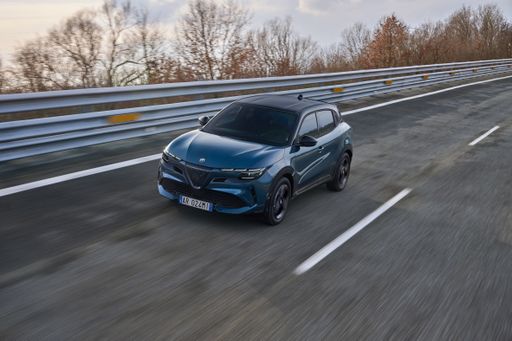 @ Alfa Romeo / Stellantis Media
@ Alfa Romeo / Stellantis Media
Alfa Romeo Junior
Alfa Romeo Junior
The Alfa Romeo Junior captures the essence of Italian design with its sleek lines and compact dimensions, making it an icon of elegance and performance. With a spirited driving experience and a charming retro aesthetic, it appeals to enthusiasts and casual drivers alike. This delightful car embodies the brand's rich heritage while remaining a fun and engaging option for those seeking a unique automotive experience.
details @ Alfa Romeo / Stellantis Media
@ Alfa Romeo / Stellantis Media
 @ Alfa Romeo / Stellantis Media
@ Alfa Romeo / Stellantis Media
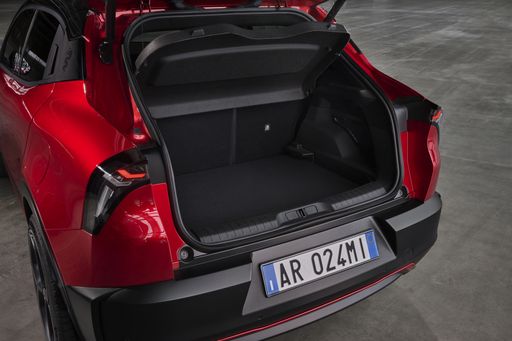 @ Alfa Romeo / Stellantis Media
@ Alfa Romeo / Stellantis Media
Ford Puma
The Ford Puma presents itself as a stylish compact SUV with a distinctive design that combines practicality with a dynamic driving experience. Its sleek lines and sporty aesthetics make it stand out on the road, while the interior offers a comfortable and tech-savvy environment. With an emphasis on efficiency and a smooth drive, the Ford Puma is well-suited for both urban commutes and countryside adventures.
details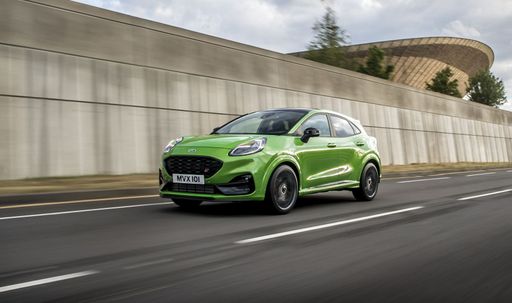 @ Ford Motor Company / Ford Media Center
@ Ford Motor Company / Ford Media Center
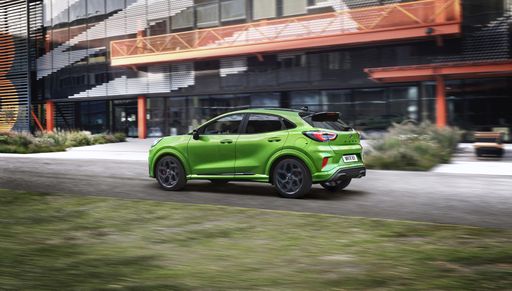 @ Ford Motor Company / Ford Media Center
@ Ford Motor Company / Ford Media Center
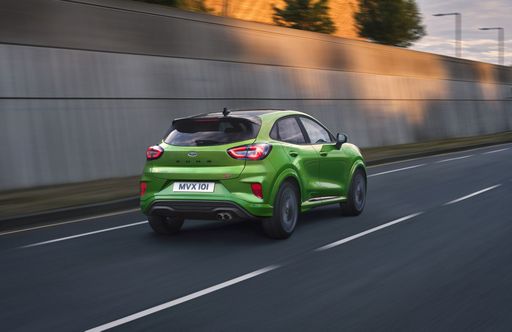 @ Ford Motor Company / Ford Media Center
@ Ford Motor Company / Ford Media Center
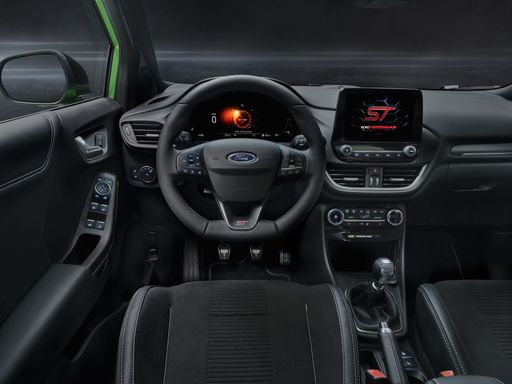 @ Ford Motor Company / Ford Media Center
@ Ford Motor Company / Ford Media Center
 @ Alfa Romeo / Stellantis Media
@ Alfa Romeo / Stellantis Media
|
 @ Ford Motor Company / Ford Media Center
@ Ford Motor Company / Ford Media Center
|
|
|
|
Costs and Consumption |
|
|---|---|
|
Price
25700 - 41600 £
|
Price
24800 - 36300 £
|
|
Consumption L/100km
4.8 - 5.4 L
|
Consumption L/100km
5.4 - 5.9 L
|
|
Consumption kWh/100km
15.1 - 17.5 kWh
|
Consumption kWh/100km
13.1 - 13.9 kWh
|
|
Electric Range
344 - 410 km
|
Electric Range
361 - 376 km
|
|
Battery Capacity
0.4 - 51 kWh
|
Battery Capacity
43 kWh
|
|
co2
0 - 119 g/km
|
co2
0 - 135 g/km
|
|
Fuel tank capacity
44 - 45 L
|
Fuel tank capacity
42 L
|
Dimensions and Body |
|
|---|---|
|
Body Type
SUV
|
Body Type
SUV
|
|
Seats
5
|
Seats
5
|
|
Doors
5
|
Doors
5
|
|
Curb weight
1380 - 1689 kg
|
Curb weight
1316 - 1563 kg
|
|
Trunk capacity
340 - 415 L
|
Trunk capacity
456 - 523 L
|
|
Length
4173 mm
|
Length
4186 - 4226 mm
|
|
Width
1781 mm
|
Width
1805 mm
|
|
Height
1505 - 1538 mm
|
Height
1550 - 1555 mm
|
|
Max trunk capacity
1205 - 1280 L
|
Max trunk capacity
1216 - 1283 L
|
|
Payload
390 - 420 kg
|
Payload
367 - 469 kg
|
Engine and Performance |
|
|---|---|
|
Engine Type
Electric, Petrol MHEV
|
Engine Type
Electric, Petrol MHEV
|
|
Transmission
Automatic
|
Transmission
Automatic, Manuel
|
|
Transmission Detail
Dual-Clutch Automatic, Reduction Gearbox
|
Transmission Detail
Reduction Gearbox, Manual Gearbox, Dual-Clutch Automatic
|
|
Drive Type
Front-Wheel Drive, All-Wheel Drive
|
Drive Type
Front-Wheel Drive
|
|
Power HP
136 - 280 HP
|
Power HP
125 - 168 HP
|
|
Acceleration 0-100km/h
5.9 - 9.1 s
|
Acceleration 0-100km/h
7.4 - 9.8 s
|
|
Max Speed
150 - 206 km/h
|
Max Speed
160 - 210 km/h
|
|
Torque
230 - 345 Nm
|
Torque
170 - 290 Nm
|
|
Number of Cylinders
3
|
Number of Cylinders
3
|
|
Power kW
100 - 207 kW
|
Power kW
92 - 124 kW
|
|
Engine capacity
1199 cm3
|
Engine capacity
999 cm3
|
General |
|
|---|---|
|
Model Year
2024 - 2025
|
Model Year
2025
|
|
CO2 Efficiency Class
A, C, D
|
CO2 Efficiency Class
A, D
|
|
Brand
Alfa Romeo
|
Brand
Ford
|
What drive types are available for the Alfa Romeo Junior?
Available configurations include Front-Wheel Drive or All-Wheel Drive.
The prices and data displayed are estimates based on German list prices and may vary by country. This information is not legally binding.
